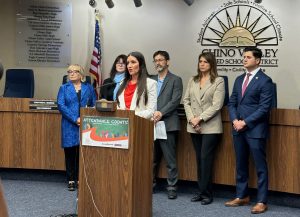The state’s abortion clinics stand to gain financially if a medical breakthrough is found.
Earlier this month, Orange County State Senator John Moorlach unsuccessfully tried to persuade his fellow senators to defund the California Institute for Regenerative Medicine (CIRM), the state’s stem cell research agency, created by voters in 2004 by Proposition 71. During the past 12 years, CIRM has spent several billion dollars to fund stem cell research in hopes of finding cures for a variety of ailments including Parkinson’s disease, cerebral palsy, and spinal cord injuries, but with little success.
Although the vote against Moorlach’s defunding effort was predictable, opposition to the bill (SCA 7) from the country’s largest abortion provider wasn’t. Moorlach’s office received five letters of opposition from different Planned Parenthood Action Packs and clinics around the state. At first glance, it might seem strange Planned Parenthood would be interested in protecting the funding for medical research that has nothing to do with “women’s reproductive rights.” Yet, Planned Parenthood’s interest might have something to do with the millions CIRM spends on research using aborted baby organs as a source of stem cells.
Dr. David A. Prentice, an Adjunct Professor of Molecular Genetics at the John Paul II Institute has been keeping an eye on CIRM’s stem cell research spending. As Vice President and Research Director for the Charlotte Lozier Institute, an organization promoting deeper public understanding of the value of human life, Prentice confirms what many Californians are unaware of.
“It is clear that California taxpayers, through CIRM, are funding projects that rely on aborted fetal tissue for experiments, including experiments injecting human fetal cells into patients,” Dr. Prentice said. “Not only do the patients need to be informed of the source of their injections, but state taxpayers need to be informed of the use of their money.”
It is unclear exactly how much money CIRM has spent over the years funding research using pre-born baby organs, but according to CIRM’s 2016 annual report, it spent seven percent of its $262 million 2016 grant budget on stem cell research on projects designated as “Other.” CIRM’s Sr. Director Public Communications & Patient Advocate Outreach, Kevin McCormack, downplayed the use of fetal tissue, but confirmed that fetal tissue research is included within the “Other” category.
McCormack also confirmed fetal tissue is being used in a clinical trial CIRM is currently promoting on its website. A article from last fall, titled, “Ingenious CIRM-funded stem cell approach to treating ALS gets go-ahead to start clinical trial,” highlights the work of Dr. Clive Svendsen, and his work to find a cure for Lou Gehrig’s disease at the Cedars-Sinai Medical Center in Los Angeles.

Dr. Svendsen, a native of England, started using pre-born baby organs as part of his research during his studies at University of Cambridge in the 1990s. He talked about this early work in an Ability Magazine article saying he was “lucky” to be involved with “fetal transplant work being done to treat Parkinson’s”.
Since then, according to his resume, Dr. Svendsen has been involved in study after study, writing article after article regarding the use of pre-born baby brains and other fetal tissue to treat neurological diseases like Parkinson’s and Lou Gehrig’s disease. Dr. Svendsen specifically moved to California in 2010 to Cedars-Sinai Medical Center to start Svendsen Laboratory, with the hopes of getting CIRM money. So far CIRM has given Dr. Svendsen $26 million, most of which has funded research to find treatments for Lou Gehrig’s disease, also known as Amyotrophic Lateral Sclerosis (ALS), a fatal condition that damages motor neurons in the brain and spinal cord.
Dr. Svendsen received his most recent grant of $6.2 million last Fall to fund a clinical trial where “they will implant middle-man “progenitor” cells made by maturing stem cells from fetal tissue,” into the spinal cords of patients with hope the damaged neural cells will be repaired.
Back in 2014, Dr. Svendsen acknowledged that using pre-born baby tissue is “ethically charged,” and he “want[ed] to get away from fetal tissue. Aborted fetal tissue is not what people want to use.”
The use of baby parts for research came to the forefront front of the nation’s conscience in 2015 when the Center for Medical Progress, lead by investigative journalist David Daleiden, exposed the existence of a raging aborted baby organ market between abortion clinics and research facilities. Right in the middle of this robust market was Planned Parenthood. Various for-profit companies were found to be facilitating this market by sending tech workers into Planned Parenthood abortion clinics to harvest the organs of aborted babies and then packaging them for resale to research facilities. Abortion clinics are legally prohibited from profiting when they donate aborted babies for research, but Daleiden exposed how a single Planned Parenthood clinic could pull in an additional $250,000 per year from these “donations.”
After intense scrutiny, Planned Parenthood announced it would no longer receive reimbursements for donating the bodies of aborted children. A spokesperson for Planned Parenthood California, Ana Sandoval, recently confirmed the abortion provider does not accept money for aborted babies, but Daleiden has his doubts.
“Because of the federated structure of Planned Parenthood and the significant independence of its affiliates, it is unlikely that any new ‘policy’ against fetal tissue remuneration is anything more than a temporary gentleman’s agreement for immediate PR purposes, and this may explain Planned Parenthood’s failure to produce a copy of it,” Daleiden wrote.
Planned Parenthood and their allies at the Capitol have been scrambling to find money to shore up the abortion giant’s funding, in anticipation of losing federal dollars. Senator Jackson introduced a personalized Pro-Choice license plate bill (SB 309) that would raise money for abortion clinics. Senator Hernandez introduced a bill (SB 473) to insure Planned Parenthood would still be eligible to receive Medi-Cal funding even if Congress puts a halt to its federal funds. This past Monday State Treasurer John Chiang announced he is going to provide health clinics like Planned Parenthood with a $20 million in one-time emergency grant to prevent clinics from closing.
Because of this financial pressure, it’s possible Planned Parenthood sees aborted babies used in stem cell research as an additional source of revenue, even though they claim not to be benefiting from the trade. It is clear more investigation is needed.
Additional information:
- CIRM put together a very emotional video asking CIRM board members to approve funding for Dr. Svendsen’s research to find a treatment for those with Lou Gehrig’s disease.
- Watch Dr. Svendsen talk about the use of fetal tissue in his research. Go to 16 minute mark to find his comment.
- Using fetal tissue for research is a common practice according to Nature.










